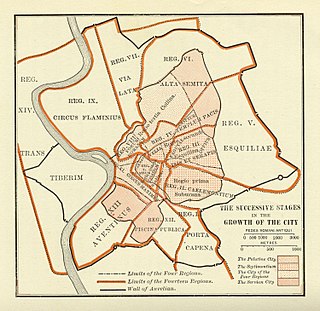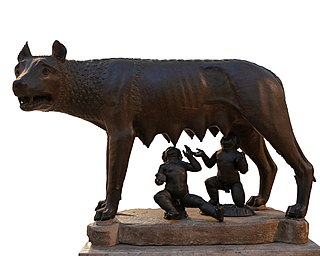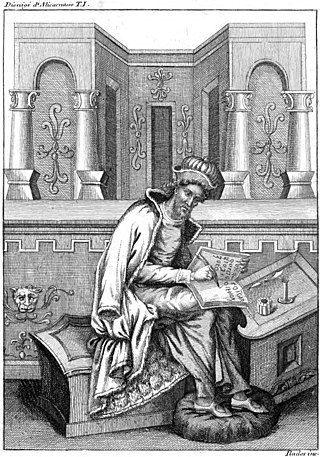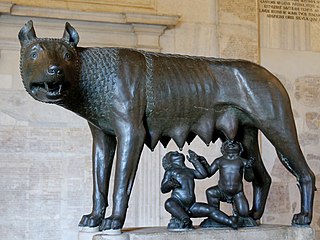
The Roman Kingdom, also referred to as the Roman monarchy or the regal period of ancient Rome, was the earliest period of Roman history when the city and its territory were ruled by kings. According to tradition, the Roman Kingdom began with the city's founding c. 753 BC, with settlements around the Palatine Hill along the river Tiber in central Italy, and ended with the overthrow of the kings and the establishment of the Republic c. 509 BC.

In Roman mythology, Romulus and Remus are twin brothers whose story tells of the events that led to the founding of the city of Rome and the Roman Kingdom by Romulus, following his fratricide of Remus. The image of a she-wolf suckling the twins in their infancy has been a symbol of the city of Rome and the ancient Romans since at least the 3rd century BC. Although the tale takes place before the founding of Rome around 750 BC, the earliest known written account of the myth is from the late 3rd century BC. Possible historical bases for the story, and interpretations of its local variants, are subjects of ongoing debate.

In Roman mythology, Faustulus was the shepherd who found the infant Romulus and his twin brother Remus along the banks of the Tiber River as they were being suckled by the she-wolf, Lupa. According to legend, Faustulus carried the babies back to his sheepfold for his wife Acca Larentia to nurse them. Faustulus and Acca Larentia then raised the boys as their own. Romulus later defeated and killed King Amulius of Alba Longa, with the help of Faustulus, and his brother Pleistinus. Romulus and Remus set out to build their own city, but then had a falling out. In the ensuing skirmish, Faustulus and Pleistinus were killed. Romulus went on to found Rome

In Roman mythology, Amulius was king of Alba Longa who ordered the death of his infant, twin grandnephews Romulus, the eventual founder and king of Rome, and Remus. He was deposed and killed by them after they survived and grew to adulthood.

Numa Pompilius was the legendary second king of Rome, succeeding Romulus after a one-year interregnum. He was of Sabine origin, and many of Rome's most important religious and political institutions are attributed to him, such as the Roman calendar, Vestal Virgins, the cult of Mars, the cult of Jupiter, the cult of Romulus, and the office of pontifex maximus.

Dionysius of Halicarnassus was a Greek historian and teacher of rhetoric, who flourished during the reign of Emperor Augustus. His literary style was atticistic – imitating Classical Attic Greek in its prime.

Tullus Hostilius was the legendary third king of Rome. He succeeded Numa Pompilius and was succeeded by Ancus Marcius. Unlike his predecessor, Tullus was known as a warlike king who, according to the Roman historian Livy, believed the more peaceful nature of his predecessor had weakened Rome. It has been attested that he sought out war and was even more warlike than the first king of Rome, Romulus. Accounts of the death of Tullus Hostilius vary. In the mythological version of events Livy describes, he had angered Jupiter who then killed him with a bolt of lightning. Non-mythological sources on the other hand describe that he died of plague after a rule of 32 years.

According to the Roman foundation myth, Titus Tatius, also called Tatius Sabinus, was king of the Sabines from Cures and joint-ruler of the Kingdom of Rome for several years.
The Consualia or Consuales Ludi was the name of two ancient Roman festivals in honor of Consus, a tutelary deity of the harvest and stored grain. Consuales Ludi harvest festivals were held on August 21, and again on December 15, in connection with grain storage. The shrine of Consus was underground, it was covered with earth all year and was only uncovered for this one day. Mars, the god of war, as a protector of the harvest, was also honored on this day, as were the Lares, the household gods that individual families held sacred.

Publius Valerius Poplicola or Publicola was one of four Roman aristocrats who led the overthrow of the monarchy, and became a Roman consul, the colleague of Lucius Junius Brutus in 509 BC, traditionally considered the first year of the Roman Republic.

The Rape of the Sabine Women, also known as the Abduction of the Sabine Women or the Kidnapping of the Sabine Women, was an incident in the legendary history of Rome in which the men of Rome committed a mass abduction of young women from the other cities in the region. It has been a frequent subject of painters and sculptors, particularly since the Renaissance.

The kings of Alba Longa, or Alban kings, were a series of legendary kings of Latium, who ruled from the ancient city of Alba Longa. In the mythic tradition of ancient Rome, they fill the 400-year gap between the settlement of Aeneas in Italy and the founding of the city of Rome by Romulus. It was this line of descent to which the Julii claimed kinship. The traditional line of the Alban kings ends with Numitor, the grandfather of Romulus and Remus. One later king, Gaius Cluilius, is mentioned by Roman historians, although his relation to the original line, if any, is unknown; and after his death, a few generations after the time of Romulus, the city was destroyed by Tullus Hostilius, the third King of Rome, and its population transferred to Alba's daughter city.

Romulus was the legendary founder and first king of Rome. Various traditions attribute the establishment of many of Rome's oldest legal, political, religious, and social institutions to Romulus and his contemporaries. Although many of these traditions incorporate elements of folklore, and it is not clear to what extent a historical figure underlies the mythical Romulus, the events and institutions ascribed to him were central to the myths surrounding Rome's origins and cultural traditions.

Alba Longa was an ancient Latin city in Central Italy in the vicinity of Lake Albano in the Alban Hills. The ancient Romans believed it to be the founder and head of the Latin League, before it was destroyed by the Roman Kingdom around the middle of the 7th century BC and its inhabitants were forced to settle in Rome. In legend, Romulus and Remus, founders of Rome, had come from the royal dynasty of Alba Longa, which in Virgil's Aeneid had been the bloodline of Aeneas, a son of Venus.
Hostus Hostilius was a Roman warrior in the time of Romulus, and the grandfather of Tullus Hostilius, the third Roman king.
The gens Gegania was an old patrician family at ancient Rome, which was prominent from the earliest period of the Republic to the middle of the fourth century BC. The first of this gens to obtain the consulship was Titus Geganius Macerinus in 492 BC. The gens fell into obscurity even before the Samnite Wars, and is not mentioned again by Roman historians until the final century of the Republic.

In Roman mythology, the Battle of the Lacus Curtius was the final battle in the war between the Roman Kingdom and the Sabines following Rome's mass abduction of Sabine women to take as brides. It took place during the reign of Romulus, near the Lacus Curtius, future site of the Roman Forum.

The Temple of Jupiter Feretrius was, according to legend, the first temple ever built in Rome. Its site is uncertain but is thought to have been on the Capitoline Hill.

In the Roman foundation myth, a she-wolf was an Italian wolf who nursed and sheltered the twins Romulus and Remus after they were abandoned in the wild by decree of King Amulius of Alba Longa. She cared for the infants at her den, a cave known as the Lupercal, until they were discovered by a shepherd, Faustulus. Romulus would later become the founder and first king of Rome. The image of the she-wolf suckling the twins has been a symbol of Rome since ancient times and is one of the most recognizable icons of ancient mythology.

Acron was the king of the Caeninenses, who rejected the proposal of the king of Rome, Romulus, which dictated that Romans intermarry with the locals of Caenina and other times. Romulus, insulted instead kidnaped Latin and Sabine woman and forced them to marry, in an event known as the Rape of the Sabine Woman.


















